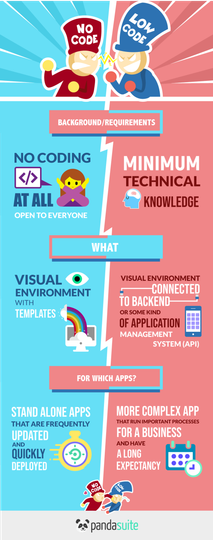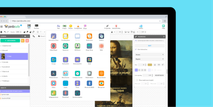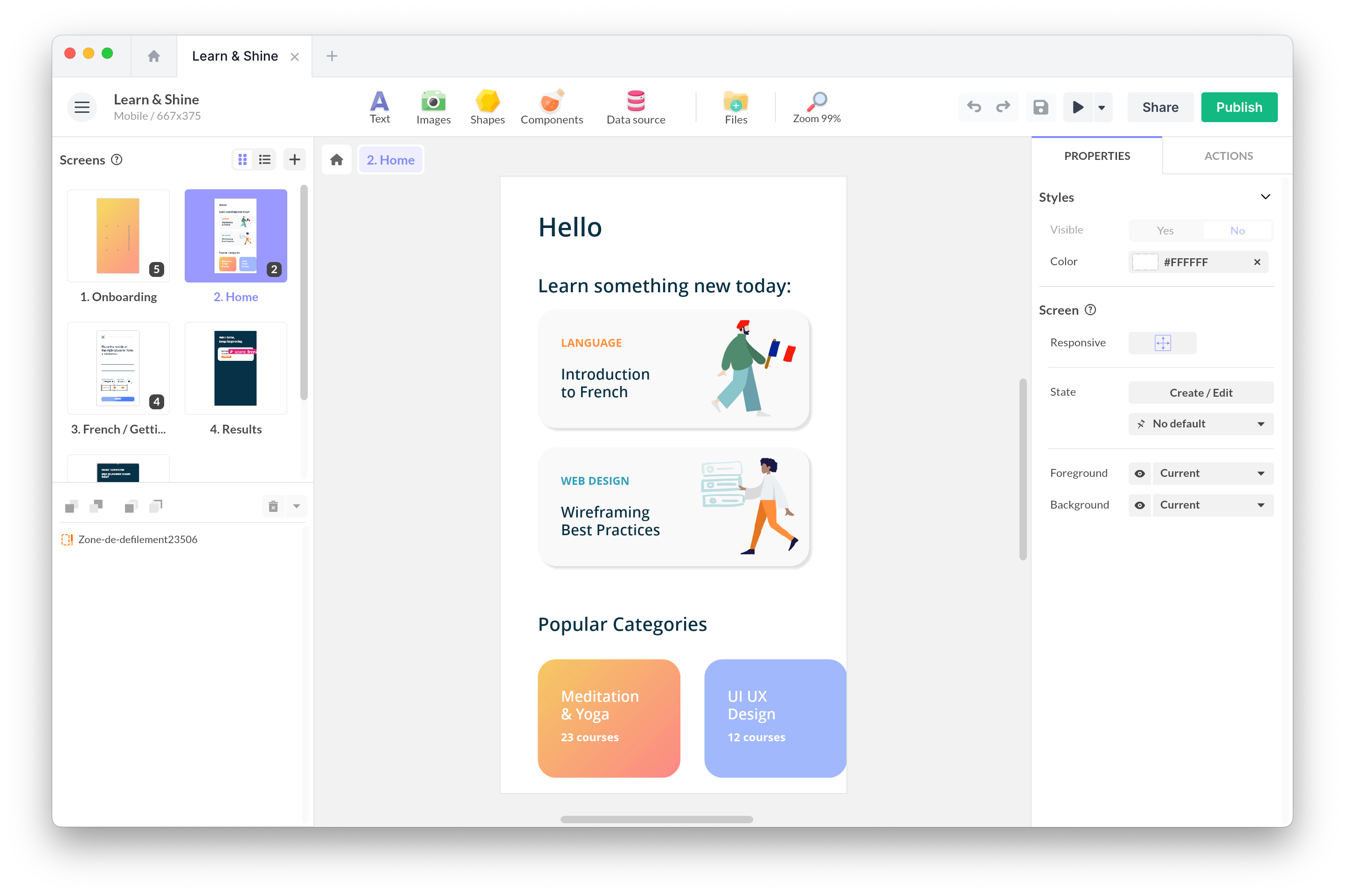Sat, Nov 13, 2021
The Power of Low-Code/No-Code App Development for Organizations

In the past, everyone had to write lines of code to create an app. But that was before. The low-code/no-code movement is here and it’s moving fast. A market study by Forrester expects the market for low-code development platforms to increase to $21.2 billion by 2022, up from $3.8 billion in 2017. And Gartner states low-code application platforms will be responsible for more than 65% of all app dev activity by 2024.
Are you ready to join the low-code/no-code movement?
Companies need more and more applications
Digital transformation is a reality for companies that want to maintain their competitive advantage. In this fast-moving world there is a growing demand from all departments to develop innovative interfaces for mobile devices and tablets. Plus, companies want to show how innovative they are by using the latest technologies such as artificial intelligence or machine learning.
Look at any IT department in a large company. IT Teams are submerged by requests and processes. Most of their time is devoted to keeping current systems working. When it comes to new projects, developers focus on large, highly scalable apps that require specific coding and show direct business impact.
Traditional computer programming takes too long and requires a special set of skills. Most of companies lack the resources to meet customer demands with frustration emerging from employees and organizations. What if non-technical employees were able to build custom applications to answer their needs and at the same time put away the pressure on their IT colleagues?
The emerging new generation of low-code and no-code solutions is the ideal opportunity for employees to develop their own applications in a secure environment and to ensure agile, trustworthy deployment.
How no-code works
Forrester argues that low-code platforms are “products and/or cloud services for application development that employ visual, declarative techniques instead of programming.”
This is called an integrated visual development environment. In this environment, non-programmers can create an application by dragging and dropping or other intuitive methods like this one. They can add their own media, use cool components, connect them together and deploy an application (web or native) without encountering any line of code.

The difference between low-code and no-code
This term low-code/no-code can be confusing because the word “code” alone is related to development skills. This clearly reflects a paradigm: how to move from a technology-driven world in which developers hold the keys to an open world in which everyone at their level can contribute to innovation. It would be great to find a new term to describe the lack of coding.
Even if they are often associated, there are some differences between low-code and no-code software. They do not address the same users and have very different requirements in terms of technical skills. No-code tools are intended for project managers and designers to solve their challenges with an app, while low-code tools are intended for programmers who want to gain speed and productivity even if they still have to write certain lines of code.

Why some IT teams feel worried
It is legitimate to have concerns when it comes to changing processes within an organization. Many of these concerns are related to the security of applications built too quickly and the possible lack of control over those issues.
However, low-code applications are spearheading some great security innovations. The latest generation of low-code/no-code solutions is based on a cloud infrastructure to facilitate creation and deployment. Cloud computing technologies incorporate the latest security standards, which helps to prevent breaches and errors that could have occurred during traditional development.
A common idea is that applications generated from low-code/no-code solutions can only be extremely simple. But most of these applications can be distributed throughout the company or to several departments. Developers can also use these tools to integrate custom code extensions and new features such as connections to external services (API, database).
Some developers believe that these new tools are a direct threat to their work. At PandaSuite, we do not believe that will replace traditional coding. On the contrary, these tools will free developers and help them to work better by focusing on high value-added tasks.
The advantages of low-code / no-code
Far from being a threat, low-code/no-code platforms tackle today’s biggest business challenge: how to be more agile in an organization.
Simplify development process
Low-code and code-free tools reduce the complexity and steps of the development process. Drag-and-drop functionality allows you to quickly create interfaces using pre-built features and resources for cross-platform deployment (mobile, tablet, desktop). There is no need to code in different languages (iOS, Android, HTML5), everything is automatically translated. And you don’t have to update your application with the latest operating system updates, the platform does it for you.
Reduce costs
Tailor-made development requires a significant investment in terms of internal resources or outsourcing costs. A low-code/no-code solution reduces the need for additional developers, which reduces hiring and service provider costs.
No more shadow IT
These tools provide a secure and manageable solution for monitoring IT activity, especially when hosted on their own secure platforms. They provide more computer connections to increase software delivery capacity.
Reduction of the IT backlog
With low-code, developers remove the simplest tasks from their planning. They focus on what matters most, increasing their daily productivity.
Encouraging initiative
Beyond the tools, the low-code/no-code approach profoundly changes the way people work within an organization.Team spirit and taking initiative are encouraged and rewarded – which stimulates team motivation. It is the emergence of the “citizen developer”.
Innovation
The use of a low code, no code platform allows you to experiment quickly with the latest technologies. Artificial intelligence and image recognition are only a new component to be integrated for these platforms into an already well-established technical base.
How PandaSuite plays a role in this movement
In the joyful world of low-code/no-code, here we are: PandaSuite. Since 2010, we work on making it easier to access to technology for all those who want to build innovative apps and new forms of engagement.
The idea of PandaSuite came just after the iPad was launched. When this new touchscreen tablet came onto the market, we thought there would be lots of highly qualitative applications and immersive experiences whether it was for the education, museum, publishing… It was a revolution and new forms of storytelling would emerge everywhere 🤩
What a disappointment! We discovered iPad applications that were unaesthetic, poorly interactive and not user-friendly. There was also some nice apps as well but just a few as they required huge investments. We investigated and we discovered how much difficult it was to build these apps: lots of time, dedicated programers... And it required to have advanced technical skills!
We said goodbye to our original photo printing project and focused all our efforts on creating an interactive no-code platform for everyone that would provide design, interactivity and cross-platform development without any technical knowledge.
The beta of PandaSuite was released in 2015. 🎉
Available for everyone
PandaSuite provides a visual interface (PandaSuite Studio) to create design, add interactive features (components) to your project and deploy it in multiple app format. Graphic designers and project managers can build their applications without any coding.

PandaSuite Studio also supports JavaScript or HTML integrations for further customization. The app can be connected to an existing backend or infrastructure. Developers can create their own customizable and reusable components to save time on app projects.
PandaSuite is simple enough for anyone to use, while providing developers with the power to create secure, complex and professional-quality applications.
Full customization
We are convinced that the best apps are unique user experiences. PandaSuite isn’t a templating tool that restricts your choices, it’s a flexible platform to build your own design and use more 30+ native components (visuals, sensors) to bring the craziest ideas to life!
There is a wide variety of apps that are created every day: sales support, integration of new employees, event apps, HR comms platform, e-learning…

Cross-platform
Built in native, PandaSuite allows you to create applications compiled in the language of each platform: iOS, Android, HTML5. We keep an eye of the latest technical innovantes and regularly enrich the platform with the most relevant functionalities to meet your needs (the latest one was image recognition!)
We provide our users with a mobile & tablet preview application (PandaSuite Viewer for iOS & Android) to test their apps instantly and real conditions of use.
Agility & Security
Every day, we talk with the IT teams of large companies (Société Générale, Engie…) to find synergies in work processes and meet all their security requirements. If necessary, we also offer on-premise hosting to install the PandaSuite platform directly on the company’s servers.
You can start for free
You can create a free account on pandasuite.com. With the free account, you can enjoy a lot of features, download PandaSuite Viewer and view your application on mobile and tablet with the PandaSuite Viewer application.
We are here to help
More than a tool, a low-code/no-code platform is also a change of culture: it means handing over application development and interface creation to people who were not previously in charge of it. That’s why we are here to help.
Since the beginning, PandaSuite has been committed to providing you with resources and support in your projects. You can find more than 150 tutorials (articles & videos) available for free and contact the team directly to answer your questions.
Today, PandaSuite helps more than 15,000 users worldwide in building their own applications either without code or with very little of it.
Join the low-code/no-code movement 🙂


